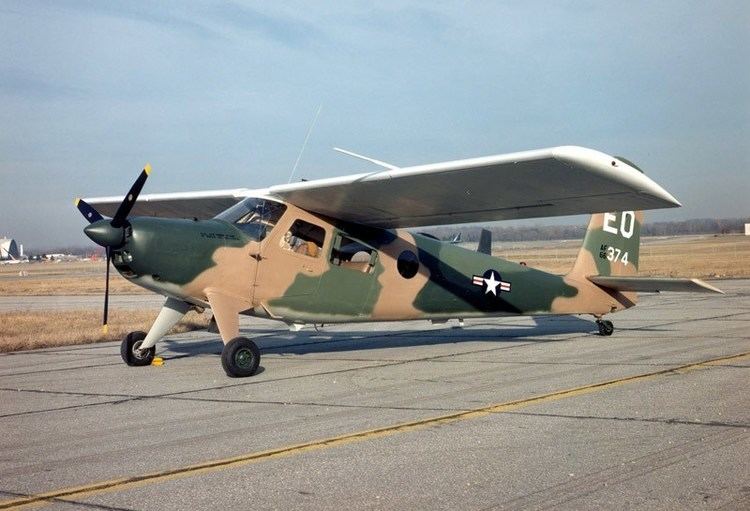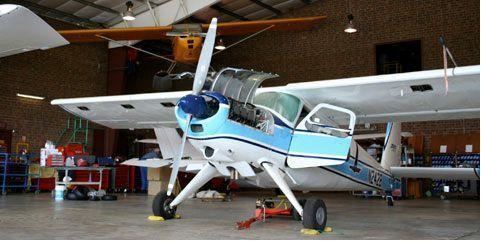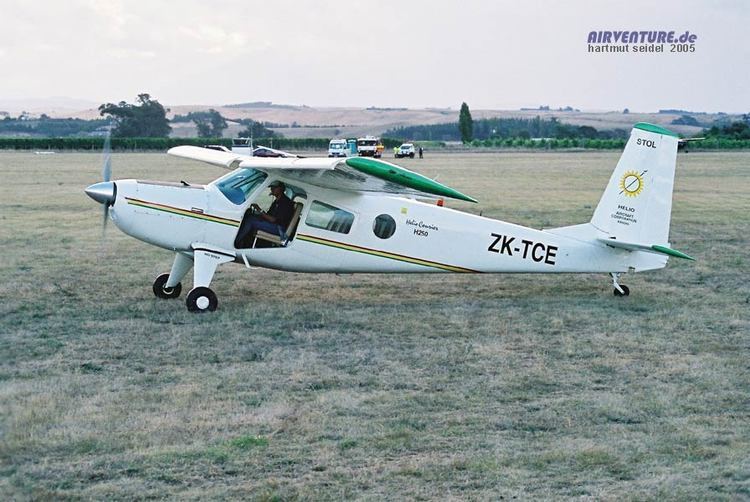Top speed 274 km/h Length 9.35 m | Wingspan 12 m Engine type Flat engine Number of seats 6 | |
 | ||
Unit cost 151,600–151,600 USD (1984) | ||
Helio courier model h 800 fly by
The Helio Courier is a cantilever high-wing light C/STOL utility aircraft designed in 1949.
Contents
- Helio courier model h 800 fly by
- Part two of helio courier demo at jaars day may 1 2010 in hd
- Design and development
- Operational history
- Variants
- Military operators
- Civil operators
- Aircraft on display
- Specifications U 10D Super Courier
- References
Around 500 of these aircraft were manufactured in Pittsburg, Kansas from 1954 until 1974 by the Helio Aircraft Company. During the early 1980s, new owners (Helio Aircraft Ltd.) made an attempt to build new aircraft with direct-drive Lycoming engines, to replace troublesome and expensive geared engines. In a further effort to reduce weight, a new composite landing gear was featured. The new models also featured modest winglets. Two models were produced, the H-800 and H-700. A total of 18 aircraft were built. The rights to the Helio Stallion and Helio Courier were acquired by Helio Aircraft of Prescott, Arizona, and will soon be returned to production.

Part two of helio courier demo at jaars day may 1 2010 in hd
Design and development

Professor Otto C. Koppen designed aircraft for the Stout Metal Airplane Division of the Ford Motor Company, including the Ford Flivver, an aircraft that was supposed to be mass-produced by Ford. Koppen went on to design the Helio Courier.

The demonstrator for the Courier's concept, "Helioplane #1", was converted by the then-local Wiggins Airways firm from a Piper PA-17 Vagabond Trainer, one of the so-named "short-wing Pipers" in production following World War II. Only the cabin area of the PA-17's original airframe remained unmodified, with the fuselage lengthened by four feet (1.2 meters), given a taller fin-rudder unit, clipped the Vagabond's stock 29 ft-3 inch (8.92 meter) wingspan down to only some 28.5 feet (8.7 meters), fitted the shortened wings with full-span leading-edge slats, long-span wing flaps that forced the ailerons to be much diminished in size, and a longer-travel main landing gear of a taller design, not unlike that of the 1930s-origin Fieseler Fi 156 German military STOL pioneer aircraft. The powerplant for the demonstrator was switched to the Continental C85 boxer-four cylinder air-cooled engine, upgraded with fuel-injection, and uniquely equipped with a multi-belt speed reduction unit to drive its Aeroproducts nine-foot (2.75 meter) diameter, variable-pitch two-blade propeller, which contributed greatly to the amazing STOL flight characteristics of the demonstrator aircraft. The demonstrator's first flight took place on April 8, 1949, flying from what was then called the Boston Metropolitan Airport, an airport located within the greater Boston suburban town of Canton, Massachusetts which was closed at the end of the 1960s, after the opening of nearby Norwood Memorial Airport (only 1.5 miles (2.5 km) NNW of the Canton facility), which itself first opened as an emergency WW II airfield in 1942.
For the construction of the production Courier aircraft, its all aluminum-clad airframe features a welded 15G steel-tube center section fuselage, with shoulder harnesses that protect the occupants in an emergency. The wings are of conventional aluminum construction, but feature Handley Page leading-edge slats that deploy automatically when the aircraft's airspeed falls below a certain value — 55 to 60 miles per hour (89 to 97 km/h). The slats contribute to the Helio's outstanding short takeoff and landing (STOL) capability, and allow for stall/spin-proof controllable flight. In conjunction with the leading-edge slats, 74% of the trailing edge incorporates high-lift slotted flaps, which together with interrupter blades atop each wing when roll control is lost at very low airspeed, allows for a tight turning radius. The Helio Courier could maintain control at speeds as low as 27 miles per hour (43 km/h).
The design of the Helio features a large vertical tail surface and rudder for control at very low flight speeds. However, on conventional geared aircraft (taildraggers), the airplane tends to be sensitive to crosswinds, thus a crosswind gear option is available, allowing the main tires to caster left or right 20 degrees, increasing the crosswind component to 25 miles per hour (40 km/h). The Helio has its main gear placement far forward of the cabin, enabling hard braking on unprepared landing areas. A tricycle-gear model was produced, but is unsuitable for unprepared rough terrain.
Helios are also capable of being equipped with floats; both straight and amphibious floats being offered.
Operational history
With a minimum-control speed of around 28 mph, the Courier is perfectly suited for confined off-airport operations. The first one was certified in July 1954 and powered by the 260 hp Lycoming GO-435-C2B2. The first production Courier (Serial Number 001, dubbed "Ol' Number 1")C-G001 was previously owned and operated by JAARS as N242B until 2010. Jaars Helio Courier has been a frequent airshow performer at EAA AirVenture Oshkosh for decades, displaying its slow flight capability in front of thousands and serving as a drop plane for the Liberty Parachute Team.
In 1957, a "Strato Courier" set an altitude record over Mexico City, Mexico at 31,200 ft powered by a geared Lycoming GSO-480-A1A5 (340 hp), only one was built. The Super Courier, a more powerful derivative, was used by the US Air Force from 1958 onward, by the US Army Special Forces in the 1960s and 1970s and by Air America during the Vietnam War as the U-10. In U.S. Army and Air Force service, the U-10 Super Courier was used for liaison work, light cargo and supply drops, psychological warfare, forward air control (Air Force), insertion and extraction land and sea (Army) and reconnaissance. Various versions were produced up through the 1980s, including turbine-powered variants.
The Super Courier saw military service in the United States as the U-10 (ex L-28). Over 120 were built: The L-28A (2, later redesignated U-10A), U-10A (26), U-10B extended range and paratrooper doors (57), and the U-10D with a higher gross weight(36). There was no U-10C.
Helios remain very popular among bush pilots in Canada (32 current) and Alaska and missionaries who fly into rough, relatively unprepared jungle airstrips because of its superior STOL abilities. Some operators use the Helio Couriers for aerial observation. Both Winged Vision Inc. of Gaithersburg, Maryland and the Pima County, Arizona, Sheriff's Department each operate two of the rare tri-gear model and mount gyro-stabilized cameras under the wing for aerial observation. Pima County mounts a FLIR camera for law enforcement, and Winged Vision mounts a high definition television camera for coverage of major sports events.
Variants
Production version of H-391, 102 built.
Military operators
Civil operators
Aircraft on display
Specifications (U-10D Super Courier)
Data from
General characteristics
Performance
